When it comes to characterising Earth’s complex and multiscale seismic behaviour and its impacts, short historical records – and even shorter instrumental records – don’t offer the long-range perspective needed to understand the drivers behind recurring high-magnitude earthquakes.
“At the moment in Australia we’re working on around a 50-year record, and there’s so much we still don’t understand about how earthquake systems work,” explains University of Western Australia’s Professor Myra Keep, whose research focuses on structural geology and tectonics.
Professor Keep is onboard the JAMSTEC-operated scientific drilling vessel Chikyu for the Personal Sampling Party (PSP) linked to International Ocean Discovery Program (IODP) Expedition 386: Japan Trench Paleoseismology, for which she is team leader for hydroacoustics.
“We’re looking for evidence of previous mega earthquakes – the huge magnitude nines – in the sediment cores and in the hydroacoustic data images and bathymetry. We’ve got some very fine control on where we are in terms of depth and what’s under the surface, and it’s going to tell us a lot more about how these systems work.”
Expedition 386 aims to fill the gap in long-term records of giant earthquakes by examining prehistoric events to construct a long-term history, delivering crucial observational data to reduce epistemic uncertainties in seismic hazard assessment in the region and beyond. According to Professor Keep, the Japan Trench is an ideal location for this work.
“It’s on a plate boundary in a highly seismically active zone, and the density of population in this region means earthquakes can have an even more devastating impact,” she explains.
“The Japan Trench is among the world’s deepest hadal trenches and is part of a complex plate boundary system where two subduction zones meet. If we can establish how frequently these earthquakes are happening and where the sediments are coming from, we can tell which sections of the plate boundary are failing, and that will give us much higher resolution data.”
It’s been an unusual expedition, and not just because it is the first Mission Specific Platform (MSP) collaboration between ECORD and JAMSTEC. Professor Keep was due to sail onboard the JAMSTEC-operated RV Kaimei in early 2020, but COVID-19 hit and Expedition 386 was delayed. It eventually went ahead in April 2021, with only a small Japanese skeleton crew onboard to collect the samples while the rest of the Science Party waited for news online.
Despite these hurdles, the mission achieved its objective of sampling 15 sites across the Japan Trench, using giant piston coring to recover 831 metres of continuous upper Pleistocene to Holocene stratigraphic successions. It also delivered two new depth records in scientific ocean drilling and coring: the deepest water site ever drilled and cored at the water depth of 8023 metres, and the deepest sub-sea level sample, recovered from 8060.74 metres below sea level.
“The capacity to take such deep samples opens up possibilities for our comprehension of the planet that have never existed before, and that’s very exciting to be part of.”
The Onshore Science Party from February to March 2022 also charted new territory as the first to take place entirely online.
“The cores were transported to Chikyu in port, and a small crew of Japanese scientists were onboard splitting and logging all the core while the rest of us were online across different time zones. There were daily midnight meetings with everyone trying to look at the samples on the screen; it was tough.”
Though the pandemic continues to wreak havoc – and Japan only recently reopened to the world – Professor Keep is delighted that the PSP is now taking place onboard Chikyu in Shimizu Port, where scientists will take 18,300 samples from the cores. She says nothing replaces the opportunity to examine the sediments in real life.
“You can make all sorts of interpretations on screen or from remotely sensed data, but there’s no substitute for getting your hands on the rock: seeing it, feeling it, and then trying to put it together in context,” she says.
“Interacting with the cores will enable me to better link the sediments to the horizons I can see in the imagery. It’s also very inspiring working alongside a brilliant international team across different fields and learning from each other; there are some really interesting ideas coming out of our discussions.”
What scientists hope to discover through Expedition 386 has direct relevance for offshore paleoseismology in Australia, and to Professor Keep’s own research into tectonics, fault reactivation and neotectonics along Australia’s North West Shelf.
“I’ve spent the last two decades looking at remotely imaged hydroacoustic and seismic data and documenting landslides in the region. Despite Australia supposedly not being particularly seismically active, and Western Australia in particular being a long way from a plate boundary, we’ve found a lot of unexpected activity,” she says.
“We have evidence of earthquakes young and old, and without those obvious plate tectonic drivers it’s difficult to explain them and understand how frequently they occur and where the stress is coming from. By looking at these sediments from an area where we know earthquakes are controlling them, we can compare this to our own data and see if there are any common characteristics.”
Professor Keep says continued international scientific ocean drilling collaboration is vital as we navigate a changing climate, growing urban populations and more frequent natural disasters with bigger impacts.
“Oceans make up 79 per cent of our planet, yet we know less about the deep ocean trenches than we do about Mars or Venus. We’re going to be looking increasingly to the oceans as our biggest unexplored resource; the more we know, the better we can understand the potential from a food security, health, and risk management perspective.”
Follow ANZIC on Twitter (@anzic_iodp) and Facebook (@ANZICIODP) for the latest news and discoveries from Expedition 386.
